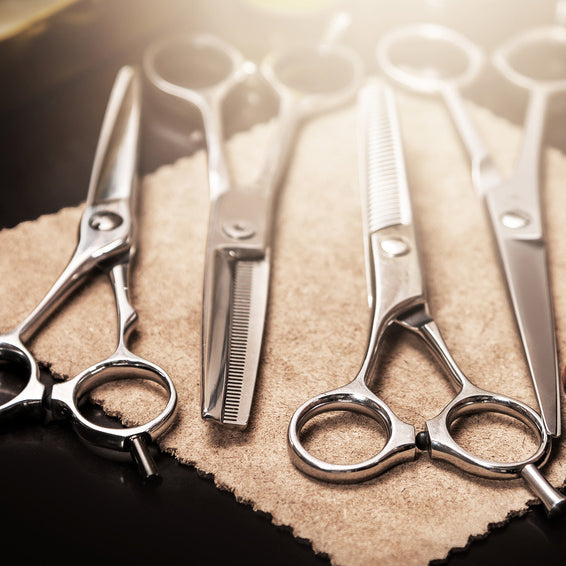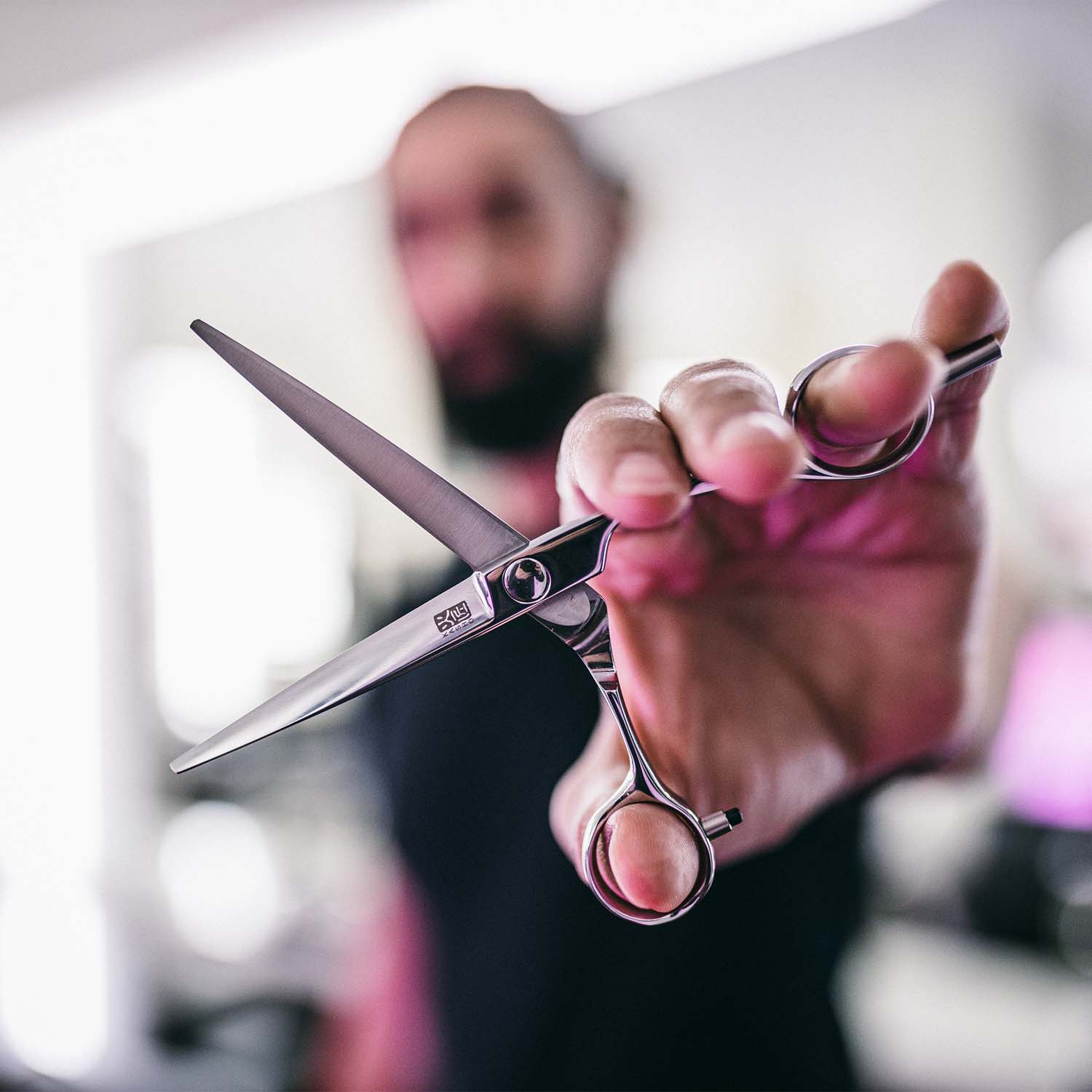Article: How To Choose The Best Professional Hair Cutting Shears

How To Choose The Best Professional Hair Cutting Shears
As a salon professional, the right shears for cutting and styling are essential tools of the trade. Before making a purchase, it's crucial to understand the basics of shears to ensure you are getting the best option for your clients and budget.
Traditional vs. Ergonomic Design
When selecting shears, one of the first decisions to make is whether you prefer a traditional design or one with ergonomic features. Traditional shears have been used for years and are known for their simplicity and reliability. On the other hand, shears with ergonomic features are designed to reduce strain on your hands and wrists, making them a popular choice among stylists who work long hours.

|
Ergonomic Shear - JW XO Shear and Blender Kit |

|
Traditional Shear - JW S4 Shear & Texturizer Kit |
Quality Materials and Craftsmanship
Investing in high-quality shears is crucial for achieving precise and smooth cuts. Look for shears that are made from superior steel and crafted with elite workmanship. These shears will not only last longer but will also provide a superior cutting experience for both you and your clients.
When shopping for shears, pay attention to the quality of the blades, the tension adjustment mechanism, and the overall construction of the shears. A well-made pair of shears will feel balanced in your hand and will allow you to cut confidently and accurately.
Remember, high-quality shears are an investment in your business that will pay off in the long run. By choosing the best shears for your salon, you can ensure that you are providing top-notch service to your clients and creating beautiful hairstyles with ease.
When it comes to selecting the perfect shears for your styling needs, understanding the materials and costs involved is crucial. JW Shears, a reputable brand in the industry offers a variety of models that caters to stylists of all levels with varying budgets.
What are the different price points available?
JW Shears line of professional shear offers shears in three different price points: low-cost, moderately priced, and premium. This allows stylists to choose a shear that fits their budget without compromising on quality.
What materials are used in the shears?
Each shear in JW Shears line are crafted with precision using high-quality materials. From the low-cost shears to the premium ones, you can expect durability and performance. The materials used ensure that the shears are not only long-lasting but also provide a smooth cutting experience.
How does the cost reflect the quality?
While the low-cost shears are budget-friendly, they still maintain a level of quality that JW Shears is known for. The moderately priced shears offer additional features and design elements, making them a popular choice among stylists. The premium shears, on the other hand, are crafted with the finest materials and cutting-edge technology, providing unparalleled performance.
Whether you are just starting out in the industry or are a seasoned professional, JW Shears has a shear that will meet your needs. By understanding the materials used and the costs associated with each shear, you can make an informed decision that will elevate your styling experience.
When it comes to choosing the right blade for your cutting needs, understanding the different types available is crucial. In the world of hairdressing and barbering, three common blade types are often used: Convex, Semi-Convex, and Beveled Edge. Each type has its own unique characteristics and is suited for different cutting techniques.
What is a Convex Blade?
A Convex blade is known for its slight curve on the blade edge that forms an angle. Also referred to as a Japanese style blade, the Convex blade comes with a very sharp edge, making it ideal for advanced cuts, finishing cuts, and chipping. However, it also requires more care and maintenance compared to other blade types due to its delicate edge.
What is a Semi-Convex Blade?
A Semi-Convex blade is a combination of convex and beveled edge blades. It features a narrower beveled edge with a slight curve, making it sharper and more durable than a beveled edge blade. The Semi-Convex blade offers the best of both worlds, providing a sharp cutting edge while maintaining durability.
What is a Beveled Edge Blade?
A Beveled Edge blade cuts well but requires more force than a convex blade. It offers a flat-surface cutting edge and is known for its edge thickness, making it durable. However, the Beveled Edge blade is not designed for advanced cutting techniques, such as slide cutting, and is better suited for basic cutting tasks.
Whether you are a professional hairstylist or simply looking to upgrade your cutting tools at home, understanding the differences between Convex, Semi-Convex, and Beveled Edge blades can help you make an informed decision. Consider the type of cuts you will be performing and the level of maintenance you are willing to commit to when choosing the right blade for your needs.
When it comes to selecting the perfect blade length for your hair shears, there are a few key factors to consider. The length of the blade can greatly impact the precision and efficiency of your cuts, so it's important to choose wisely.
What factors should you consider when choosing a blade length?
One of the most important factors to consider when selecting a blade length is the size of your hand. A blade that is too long or too short for your hand can make it difficult to achieve the level of control you need for precise cutting.
Additionally, the type of technique you'll be performing should also influence your decision. Shorter blades, typically up to 5.5 inches, are ideal for intricate cuts and touch-ups, while longer blades are better suited for cutting thick hair or performing techniques like slide cutting.
How does blade length affect your cutting style?
Shorter blades are perfect for detailed work and cutting close to the skin, making them a popular choice for barbers and stylists who specialize in precision cutting. On the other hand, longer blades are preferred for techniques like scissor-over-comb styling and cutting thick hair.
Professionals often own shears with different blade lengths to accommodate a variety of cutting styles and techniques. For example, a 5.5 to 5.75 inch shear size are commonly used by professional stylists for its versatility and ability to handle a wide range of cutting tasks.
Ultimately, the right blade length for you will depend on your hand size, cutting technique, and the type of hair you'll be working with. By choosing a blade length that aligns with these factors, you can ensure that you have the control and precision you need to create flawless cuts every time.
Have you ever stopped to think about the design of the handle on your tools? Believe it or not, the handle plays a crucial role in how comfortable and efficient a tool is to use. Let's explore the differences between straight handles and offset handles.
What is a Straight Handle?
A straight handle, also known as an opposing handle or opposing grip, is the oldest style of handle. It is a simple design where the handle is in line with the tool itself. While this design may seem straightforward, it is not the most ergonomic option available.
What is an Offset Handle?
On the other hand, an offset handle is the most popular type of handle on the market today. This design is ergonomically crafted to reduce fatigue and strain on the user's hand and wrist. The offset handle includes the crane-style design, which provides a more natural grip and better control over the tool.
When comparing the two handle types, it is clear that the offset handle offers superior comfort and usability. The ergonomic design of the offset handle makes it the preferred choice for professionals and hobbyists alike.
Next time you're in the market for a new tool, consider the handle design and opt for an offset handle for a more comfortable and efficient user experience.
As a professional in the industry, understanding how to properly adjust the tension on your shears is crucial for optimal performance. The adjustment screw plays a key role in ensuring that your shears function at their best. Let's dive into how to master the adjustment screw on your shears.
What is the Adjustment Screw?
The adjustment screw on your shears is a small, but mighty component that allows you to fine-tune the tension between the handle and blade. This adjustment is essential for achieving smooth and precise cuts with your shears.
How to Adjust the Tension
To adjust the tension on your shears, start by holding them upright vertically. The blade with the finger rest should drop one-third to one-half way down if the tension is correct. If the blade does not drop or drops too much, it's time to make an adjustment.
Why Proper Adjustment is Important
Proper tension adjustment ensures that your shears operate smoothly and efficiently. It also helps prevent strain on your hand and wrist, reducing the risk of fatigue or injury during prolonged use.
By mastering the adjustment screw on your shears, you can maintain their performance and prolong their lifespan. Remember to regularly check and adjust the tension to keep your shears in top condition for all your cutting needs.
Straight or Standard
The standard or flat thumb ring is a traditional option that provides a simple and straightforward design. It offers a flat surface for the thumb to rest on, providing stability and control during cutting. This type is popular among hairstylists who prefer a classic and comfortable thumb ring.
Offset
An angled thumb ring is designed to provide ergonomic support and reduce strain on the hand and wrist. The angled shape promotes a more natural thumb positioning, enhancing comfort and reducing fatigue during long hours of cutting. This type is favored by stylists who prioritize ergonomics and comfort.
Swivel
The swivel thumb ring offers the most natural thumb positioning by allowing the thumb to rotate freely. This type enables a wider range of motion and flexibility, enhancing precision and control while cutting. The swivel design is popular among stylists who value fluidity and ease of movement.
By investing in quality shears, you are not only improving the quality of your work but also investing in the longevity of your tools. Quality shears are built to last, meaning you won't have to replace them as frequently as lower-quality options. This can save you money in the long run and ensure that you always have reliable tools at your disposal.
By taking the time to learn more about the essential tools of your trade, you can make informed decisions that will benefit both your work and your business. Investing in quality shears is a smart choice that can positively impact your results and your overall satisfaction with your work.



Leave a comment
This site is protected by hCaptcha and the hCaptcha Privacy Policy and Terms of Service apply.